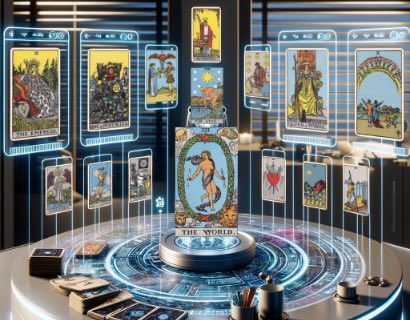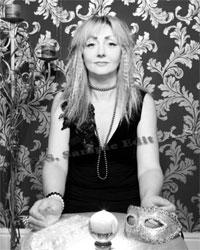|
Deck: Encore Tarot
by Ciro Marchetti. |
Created on Phuture Me |
Also available in our Tarot & Numerology App for Apple iOS & Android
 |
 |
Screenshot
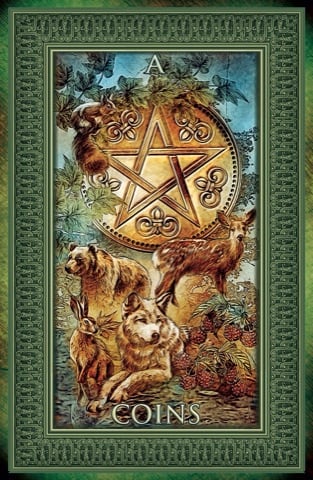
Aces are numerically the lowest ranking card in any deck of cards, playing or tarot. Probably due to modern concept of Aces High, which has been popularised in music, media and card games, we place great value on the ace as it has become a modern symbol of good luck. Before printed playing cards, when dice playing was more common, the 1 represented bad luck due to its low value. In reading tarot it is good practice not to jump to immediate, and literal, conclusions when particular cards appear. A tempered, open minded and intuitive approach should always be taken to all negative cards, and supposedly positive cards, in interpreting their meaning. The Ace of Pentacles is one such card that can inspire excitement at its appearance, supposedly promising a new, unexpected, material endowment. Sometimes it does herald a gift or an unexpected windfall but more often it signifies other aspects of an Ace's symbology.
Material endowments require an initial seed investment to start them off followed by careful cultivation and nurture to keep them growing larger and stronger. The Ace of Pentacles symbolises something materially new, it is like a seed placed in the earth that has the potential to grow into something of greater value. It is not alone in the Suit of Pentacles as a card with a single Pentacle as each character in the court cards holds one. The Page lacks the experience, or responsibility, to handle this new wealth. The Knight guards wealth preventing unnecessary distribution or loss. The Queen uses it to nurture growth through patronage. The King maintains wealth keeping what he has and ensuring healthy, risk free, growth.
Numerology isn't well known or understood but there is no need to explain what the number 1 symbolises to most people. It's the number of a winner, a leader. It is premium and premier. These are the desired traits we all easily associate with 1 but we must remember that 1 is also symbolic of a beginning, a first step in a sequence, cycle or journey. It can also symbolise independence and individualism.
The Rider Waite Smith (RWS) deck added a walled garden, with lilies growing in it, as a background to the Ace of Pentacles and included a hand, holding the pentacle, coming out of a cloud hovering over the ground. The Lily is symbolic of chastity, innocence and purity. The inclusion of the cloud, as the source of the hand, is there to symbolise the divine origin of all things. It serves to remind us of the greatest mystery of all - where does everything come from, and return to, including ourselves?
The Ace of Pentacles can herald a new material endeavour or project rather than simply receiving something unexpectedly. This can be both positive or negative. For example a new investment or job which will take time, and further steps, to realise any gain. Or it could be a new and unexpected expense, or financial commitment, that maybe a one time payment or a cycle of payments. A Tarot deck has five Aces, if you include The Magician from the Major Arcana, but it also has five 10s, including the The Wheel of Fortune. This is an important point to keep in mind as the Ace is symbolic of only a beginning. It does not symbolise completion and achievement because that attribute belongs to 10. In numerology the number 10 reduces to 1 (1+0=1). In the 10 Of Pentacles we see the results of one, or many, completed cycles that are material in nature. The relationships between the Wheel of Fortune, card 10 of the Major Arcana, and the Aces should remind us that each cycle can be different. Some will be rewarding and others difficult as luck depends on the outcome of spinning the wheel of fortune. It's tempting, especially as a beginner, to pull just a single card using Tarot for divination but this runs the risk of "a little knowledge is dangerous". The bigger picture, given by larger spreads, will always help to temper interpretation of cards that roll the dice of luck like Aces.
The Ace of Pentacles, or the Ace of Coins, is traditionally represented as a single pentacle, or coin. It's symbology is simple, it has the element of earth and a numerological value of 1. In numerology the 1 represents both rank and beginning. The Ace of Pentacles could symbolise one's most prized, or valuable, possession e.g. a car, a home etc. As a beginning it could represent a new job, income source or investment.
© Phuture Me Ltd 2010-2018. All rights reserved.
THE PICTORIAL KEY TO THE TAROT
By Arthur Edward Waite (1911)
A hand issuing, as usual, from a cloud holds up a pentacle. Divinatory Meanings: Perfect contentment, felicity, ecstasy; also speedy intelligence; gold. Reversed: The evil side of wealth, bad intelligence; also great riches. In any case it shews prosperity, comfortable material conditions, but whether these are of advantage to the possessor will depend on whether the card is reversed or not.
Related Tarot Cards
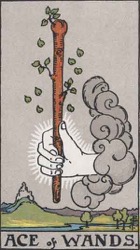 |
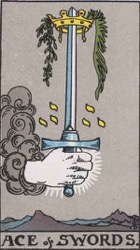 |
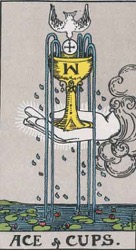 |
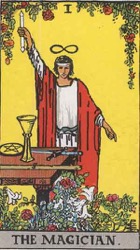 |
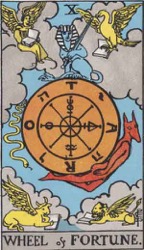 |
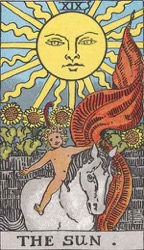 |
© Phuture Me Ltd 2018. All rights reserved.
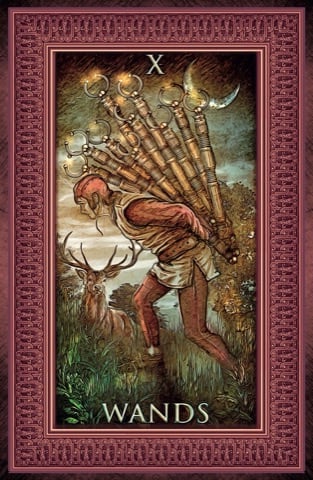
The 10 of Wands marks the completion of one, or many, cycles within the element of Fire and the beginning of a new cycle. The element of Fire, represented by the Suit of Wands, symbolises energy, passion and drive. It is the fire that burns in the home and within the engines of our transport and industry. The 10 of Wands is a collection, or a gathering together, of projects and jobs in the home or the work place for the purpose of moving ahead on something new. Smaller projects or plans maybe the individual blocks of a much larger and more ambitious project which is what the 10 of Wands symbolises. The 10s in tarot tend to include more than one person unlike the solitary natured 9s and this card's appearance is more likely to suggest a collective effort rather than an individual one.
Numerology reduces 10 to a 1 (1+0=1) and this connects Tarot's 10s to its Aces. The difference being that the Ace symbolises something entirely new without any prior existence. The 10 also has the symbology of something new but built upon one or more previous cycles.
The artist of the the Rider Waite Smith (RWS) deck, Pamela C. Smith, has taken her inspiration for the 10 of Wands from oldest known 78 card Tarot deck's 10 Of Swords. The Sola Busca Tarot depicts a man placing 10 swords in a bag attached to a manger ring on a wall, his body is in the same position with his head down. In 1907, two years prior to the publication of the RWS deck, the British Museum received photographs of the complete Sola Busca tarot deck which they put on display in London where Waite and Smith were based. Many details from this old deck have been re-used in the RWS, the 3 Of Swords being almost identical. This symbolic theme of the collectiveness of the number 10 was passed over for the RWS 10 of Swords in favour of the 10 of Wands but it is worth remembering these alternative interpretations when intuitively feeling for the correct meaning and interpretation of either of these cards. The image depicted in the RWS 10 of Wands often gives an initial impression of a man struggling to pick up and carry 10 long sticks which leads to the common interpretation of being overburdened or having taken on too many projects at the same time.
The 10 of Wands, 10 of Rods or 10 of Batons, is a card of heavy burdens, long term ambitions and large projects. The element here is Fire which relates to energy, drive, home, community and work. The number 10 in numerology, like the 1, is symbolic of something new but different because it is built upon something else, something that already exists.
© Phuture Me Ltd 2010-2019. All rights reserved.
THE PICTORIAL KEY TO THE TAROT
By Arthur Edward Waite (1911)
A man oppressed by the weight of the ten staves which he is carrying. Divinatory Meanings: A card of many significances, and some of the readings cannot be harmonized. I set aside that which connects it with honour and good faith. The chief meaning is oppression simply, but it is also fortune, gain, any kind of success, and then it is the oppression of these things. It is also a card of false-seeming, disguise, perfidy. The place which the figure is approaching may suffer from the rods that he carries. Success is stultified if the Nine of Swords follows, and if it is a question of a lawsuit, there will be certain loss. Reversed: Contrarieties, difficulties, intrigues, and their analogies.
Related Tarot Cards
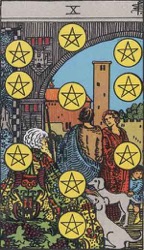 |
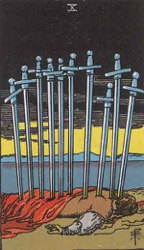 |
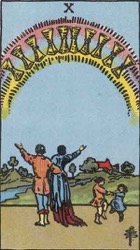 |
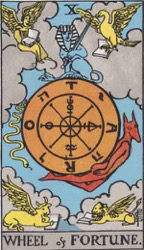 |
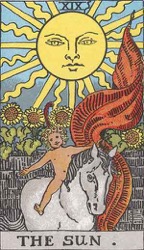 |
© Phuture Me Ltd 2019. All rights reserved.
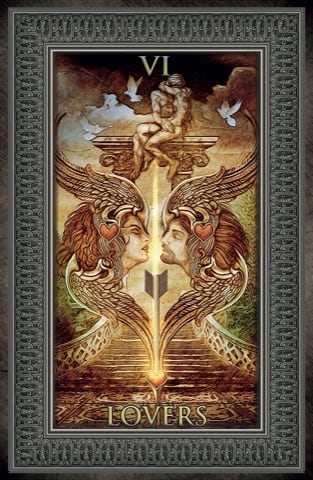
It's important to note that The Lovers evolved into Adam and Eve, in the Garden of Eden, with the publication of the Rider-Waite-Smith (RWS) Tarot deck in 1910. Traditionally this tarot card depicted a well dressed couple receiving a blessing of their union from a king. Above them, with the sun in the background, hovers cupid ready to shoot with his bow and arrow.
What theme was the artist, Pamela Coleman Smith, trying to capture with this break from tradition and inclusion of christian mythology? Many of the changes that Smith brought to Tarot could be attributed to her excellent understanding of numerology and a desire to enhance Tarot's symbolic cohesiveness. The key theme of the number 6 in numerology is one of responsibility to those closest to us; family, friends and colleagues. It is not a number of emotional union, the 2 Of Cups would be a better match. Comparing it to the emotional card of the same number, the 6 Of Cups, would suggest that it is more platonic than its name would suggest.
The nudity of Adam and Eve in the RWS deck, in addition to the card's name, often misleads to a theme of sexuality. The book of Genesis (2:25) states "Both the man and his wife were naked, yet felt no shame.". The nudity of these characters represents innocence. After eating the forbidden fruit (Genesis 3:7) they became self aware and covered themselves. Innocence lost, which is where this card makes a numerological connection to the 15th card of the Major Arcana, The Devil.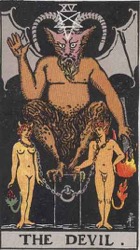 In numerology The Lovers and The Devil are both 6 as 15 reduces to 6 (1 + 5). The RWS Devil shows us the same couple from The Lovers chained to an alter with the Devil sitting on it. This connection between these two cards serves as a warning of the consequences of acting irresponsibly when you are in a good place. The Lovers will often appear as a reminder to appreciate what you have and protect it from un-wise choices and temptations. There are things we do in life, or choices we make, that cannot be undone. An innocent, platonic relationship between two friends changes forever when they become lovers.
In numerology The Lovers and The Devil are both 6 as 15 reduces to 6 (1 + 5). The RWS Devil shows us the same couple from The Lovers chained to an alter with the Devil sitting on it. This connection between these two cards serves as a warning of the consequences of acting irresponsibly when you are in a good place. The Lovers will often appear as a reminder to appreciate what you have and protect it from un-wise choices and temptations. There are things we do in life, or choices we make, that cannot be undone. An innocent, platonic relationship between two friends changes forever when they become lovers.
The traditional, pre-RWS, depiction of what appears to be a marriage is probably based on Catholicism's prohibition on divorce. Once a marital union is made it cannot be broken until at least one person dies. The Lovers therefore symbolises an irreversible choice and course of action. The RWS change is probably in response to changing modern times with higher instances of divorce and re-marriage as well as the adoption of tarot in cultures not so heavily influenced by the catholic church (ie England where Waite and Smith were based.)
The sun in the background is the one symbolic feature from the traditional tarot decks that was retained by the RWS deck. In the RWS deck only three cards have the sun at its zenith in the background sky. The Fool, The Lovers and The Sun. The Lovers and The Sun are dominated by the element of Fire which is opposite to the element of Water (emotions and love). The element of fire, like the 6 in numerology, symbolises the home and community in which we live and work. The Sun brings success, abundance, fertility and growth which, according to The Book of Genesis, is what the Garden of Eden provided, everything man and woman could want in one place. A paradise that was lost due to temptation, a bad choice and evil influence.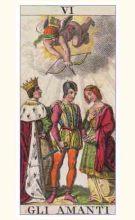
There is a prevailing theme of darkness in the Major Arcana between card 6, The Lovers, and card 19, The Sun. Nothing good ever lasts and should be treasured and appreciated when received, each day taken as a gift. When the sun does finally set, and night falls, we are comforted by the knowledge that the sun will always rise again tomorrow.
Just as the appearance of Death in a Tarot spread doesn't generally indicate the death of someone nor does the appearance of The Lovers card indicate a new love interest or a romantic physical encounter. Tarot can be literal, and on occasion this maybe the message, but it is good practice when reading tarot spreads not to jump to literal conclusions each time these cards appear.
© Phuture Me Ltd 2010-2018. All rights reserved.
THE PICTORIAL KEY TO THE TAROT
By Arthur Edward Waite (1911)
The sun shines in the zenith, and beneath is a great winged figure with arms extended, pouring down influences. In the foreground are two human figures, male and female, unveiled before each other, as if Adam and Eve when they first occupied the paradise of the earthly body. Behind the man is the Tree of Life, bearing twelve fruits, and the Tree of the Knowledge of Good and Evil is behind the woman; the serpent is twining round it. The figures suggest youth, virginity, innocence and love before it is contaminated by gross material desire. This is in all simplicity the card of human love, here exhibited as part of the way, the truth and the life. It replaces, by recourse to first principles, the old card of marriage, which I have described previously, and the later follies which depicted man between vice and virtue. In a very high sense, the card is a mystery of the Covenant and Sabbath.
The suggestion in respect of the woman is that she signifies that attraction towards the sensitive life which carries within it the idea of the Fall of Man, but she is rather the working of a Secret Law of Providence than a willing and conscious temptress. It is through her imputed lapse that man shall arise ultimately, and only by her can he complete himself. The card is therefore in its way another intimation concerning the great mystery of womanhood. The old meanings fall to pieces of necessity with the old pictures, but even as interpretations of the latter, some of them were of the order of commonplace and others were false in symbolism.
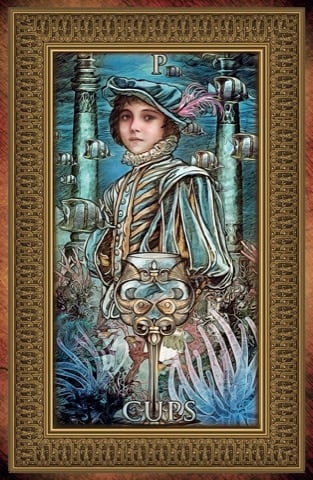
Tarot Page's, like the Page of Cups, are related to The Fool. They can be thought of as Minor Fool's who's focus is on their element, in this case water, rather than being spiritually focused like the Major Arcana's Fool.
The central theme of these Fool's is one of not following rational, or conventional, approaches to life. Not caring what other's think (named fool because that's what others think) and following one's gut, or instincts. Not being trapped by dogma. Listening to their own inner voice instead of the voices of others. Pages are dreamers and some are capable of turning their dreams into reality.
With the Page of Cups this "foolish" approach is towards the emotional aspects of life. The surrounding cards should give clues to this path being a happy, benign or unhappy one in it's outcome. You may be planning to spend the weekend with your friends, family or loved one and pulled a single card to see if your plans will work out. You get the Page of Cups. Tarot is reflecting your state of mind. You are dreaming of previous good times and desire more of the same. Can that dream be a reality? Tarot is making you question yourself and state of mind. Are you setting yourself up for a disappointment? Do you need to take a more mature approach to where you want to be and what you want to happen?
The Page of Cups, as a person, would be a male or female child who could be sensitive, shy, loving, emotional, introspective, quiet or gentle in nature. This child maybe musical or artistically inclined, or simply a child that loves playing around water or swimming.
Pages are also messengers and their appearance in Tarot more commonly signifies a message or news. This news could be from a loved one, a family member and/or will be of an emotional content, for example, regarding a pregnancy, birth, engagement or wedding. It could simply be a kind offer of help from a friend.
Pay close attention to the details of the imagery for the Page of Cups you have in your deck. The Rider-Waite-Smith Tarot has a Page holding a cup containing a fish. This could represent an aquarium or even fishing as a sport. The RWS Page of Cups stands on a beach with the sea in the background. As a situation this card could mean playing a game at a beach, on water or the sea.
© Phuture Me Ltd 2010-2018. All rights reserved.
THE PICTORIAL KEY TO THE TAROT;
By Arthur Edward Waite (1911)
A fair, pleasing, somewhat effeminate page, of studious and intent aspect, contemplates a fish rising from a cup to look at him. It is the pictures of the mind taking form. Divinatory Meanings: Fair young man, one impelled to render service and with whom the Querent will be connected; a studious youth; news, message; application, reflection, meditation; also these things directed to business. Reversed: Taste, inclination, attachment, seduction, deception, artifice.
Related Tarot Cards
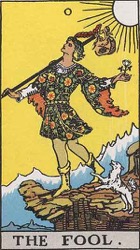 |
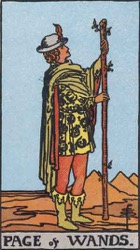 |
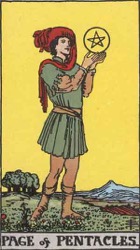 |
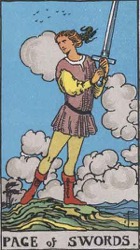 |
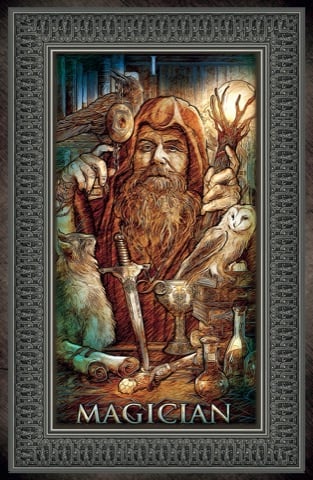
Probably the easiest cards to understand in Tarot are the Aces. We are all very familiar with the symbology of the number 1 without any knowledge of Numerological symbology. To be called number 1, to be 1st, to take the 1st step, a new beginning. Each Ace in the Minor Arcana focuses on it's elemental beginning. The Magician is the Ace of Aces. In general Tarot decks depict The Magician with all four elements in some form. The Rider Waite Smith (RWS) deck has a Cup, a Sword, a Stick and a Coin engraved with a Pentacle lying on a table in front of The Magician. His right hand holds a wand pointing at the Heavens and the left points at the earth. Above his head a halo of infinity. This is a card about creative power. To be able to combine the 4 elements into a sum great than it's parts he calls on the eternal where heaven and earth meet. True creativity, art and inspiration don't come from merely a process of thought, that would be the Ace of Swords, it comes from the soul, the ghost within us, the silent watcher that is consciousness itself. When we quieten our minds and bring together all that we have in front of us (the table & it's objects) we can begin to achieve wonderful things. The Magician is there to remind you of your divine gift of creation. Don't squander this opportunity to start bringing something truly wonderful into this world.
The Magician is the first numbered card in the Major Arcana. It's numerology is important as this card is a card of power as well as creativity. The Magician has the power to creative something from nothing. The Magician also has the power to transform. Power however can corrupt. Surrounding cards may indicate warnings of the misuse of the power that this card points too. They can also point to channels for good use of this power. Whatever the situation the person has the abilities to take control, create the new or change the existing into something better.
This card also comes with a warning to be wary of tricksters. Surrounding cards that point to hidden plots and activities may indicate that The Magician is someone not to be trusted.
© Phuture Me Ltd 2010-2018. All rights reserved.
THE PICTORIAL KEY TO THE TAROT
By Arthur Edward Waite (1911)
A youthful figure in the robe of a magician, having the countenance of divine Apollo, with smile of confidence and shining eyes. Above his head is the mysterious sign of the Holy Spirit, the sign of life, like an endless cord, forming the figure 8 in a horizontal position . About his waist is a serpent-cincture, the serpent appearing to devour its own tail. This is familiar to most as a conventional symbol of eternity, but here it indicates more especially the eternity of attainment in the spirit. In the Magician's right hand is a wand raised towards heaven, while the left hand is pointing to the earth. This dual sign is known in very high grades of the Instituted Mysteries; it shews the descent of grace, virtue and light, drawn from things above and derived to things below. The suggestion throughout is therefore the possession and communication of the Powers and Gifts of the Spirit. On the table in front of the Magician are the symbols of the four Tarot suits, signifying the elements of natural life, which lie like counters before the adept, and he adapts them as he wills. Beneath are roses and lilies, the flos campi and lilium convallium, changed into garden flowers, to shew the culture of aspiration. This card signifies the divine motive in man, reflecting God, the will in the liberation of its union with that which is above. It is also the unity of individual being on all planes, and in a very high sense it is thought, in the fixation thereof. With further reference to what I have called the sign of life and its connexion with the number 8, it may be remembered that Christian Gnosticism speaks of rebirth in Christ as a change "unto the Ogdoad." The mystic number is termed Jerusalem above, the Land flowing with Milk and Honey, the Holy Spirit and the Land of the Lord. According to Martinism, 8 is the number of Christ.
Related Tarot Cards
 |
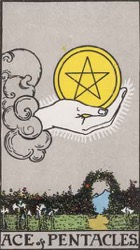 |
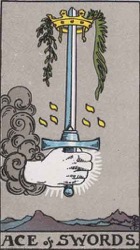 |
 |
© Phuture Me Ltd 2018. All rights reserved.
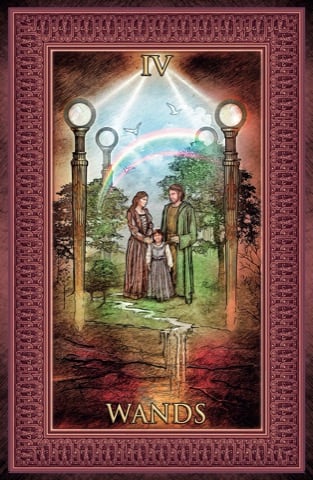
The element of Fire, represented by the Suit of Wands, symbolises energy, passion and drive. It is the fire that burns in the home and within the engines of our transport and industry. The 4 of Wands is symbolic of a rigid structure, something that is strong, stable, reliable, dependable and trustworthy. There are many ways to interpret this card within these parameters, for example energy, fire and passion contained and controlled in a reliable and safe way. As Fire is symbolic of the home, being the heart of the home, another example would be a safe and secure home environment. Its symbolism is not limited to the home but also encompasses community and place of work. Therefore this card can also symbolise a reliable job which might be a bit mundane and hard work but it would be a reliable source of income.
The characteristics of the number 4 in numerology are immutability, stability, reliability and hard work. It is the number of a strong foundation upon which an enduring structure is constructed. All the cards in Tarot with a numerology of 4 share these characteristic traits. The Kings and The Emperor represent trustworthy and dependable characters on whom you can always rely on within their elemental domain. Even in the troublesome Suit of Swords the 4 Of Swords is symbolic of mental stability. The 4 of Wands symbology, taken from combining its numerology and element, is one of a home, community, job, ambition or project with a strong foundation. This is either past, present or future. In the past this maybe the foundation on which the current and future situation is based. In the present it would represent creating a strong foundation, which will take a lot of hard work and perseverance but will have a long term benefit. In the future it would suggest that plans are being made for the formation of something enduring in the future.
The Rider Waite Smith (RWS) deck depicts the 4 of Wands as 4 staves, as A.E Waite refers to them as, fixed into the ground making a pergola which is adorned with a garland. In the background two well dress women, wearing laurel crowns, hold up bouquets and a crowd of people can be seen further back. The image is one of a celebration but what is being celebrated has been left open to interpretation. A common meaning associated with this card is that it represents a marriage ceremony which is another way of interpreting its symbolism. It would be the initiating foundation of a home through ceremony and celebration. It has to be remembered that this is only the start, the first spade breaking earth or brick being laid, which is sometimes celebrated. A lot of hard work, patience and perseverance will be required long after the party is over to make this work.
The 4 of Wands, 4 of Rods or 4 of Batons, is a card of structure, security and strong roots in a home, community or work place. The element here is Fire which relates to home, community and work. The aspects of the number 4 in numerology are patience, perseverance, hard work, stability and rigidity. For example, the 4 of Wands can point to moving into, and setting up, a new home. The 4 is a rigid and stable number and within the Suit of Wands it can represent the solid foundations of a family, home, community or work place and long term commitments being made.
© Phuture Me Ltd 2010-2018. All rights reserved.
THE PICTORIAL KEY TO THE TAROT
By Arthur Edward Waite (1911)
From the four great staves planted in the foreground there is a great garland suspended; two female figures uplift nosegays; at their side is a bridge over a moat, leading to an old manorial house. Divinatory Meanings: They are for once almost on the surface--country life, haven of refuge, a species of domestic harvest-home, repose, concord, harmony, prosperity, peace, and the perfected work of these. Reversed: The meaning remains unaltered; it is prosperity, increase, felicity, beauty, embellishment.
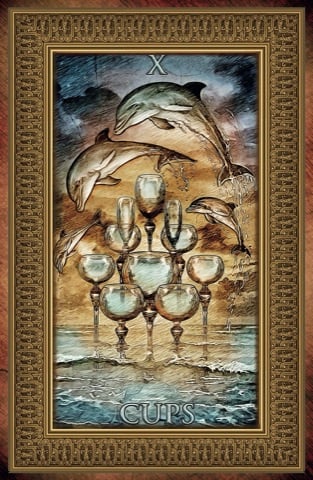
With the 10 of Cups life really doesn't get any better than this if love and family are the things that are most important to you. If romance is on your mind then the 10 of Cups isn't just saying yes it's also saying romance and a long term, happy relationship.
The 2 Of Cups is a great card to draw if you have a romantic interest in someone. It says the interest is mutual and could progress as desired. The length, quality and compatibility remain unknown and open. This is where the 10 of Cups is a much better card to draw as it not only foretells of a relationship but a good one which will be lasting. In the Rider Waite Smith (RWS) deck the artist, Pamela C. Smith, used the same background in both the 2 of Cups and 10 of Cups. The 2 of Cups therefore marks the first stage in a long journey towards reaching the goal, and romantic ambitions, of its courting couple.
The Lovers too is favourable but it comes with a warning to be cautious as The Lovers is about being careful with choices which, once made, cannot be undone. If The Lovers is, as it can do from time to time, giving a literal answer it is focusing on the short term and not the long like the 10 of Cups. It's always worth asking why Tarot picked a particular card and not another one. Take care not to jump to overly positive conclusions because a card is a close match to the answer you wanted.
The preceding card in the Suit of Cups, the 9 Of Cups, is also a card of emotional fulfillment, happiness and contentment but the number 9 in numerology is card of solitude as can be seen from the 9th card of the Major Arcana being The Hermit. Some people are just happy on their own and these are their cards.
To understand why the 10 of Cups is a long term relationship card one must consider the implications of the number 10 in numerology together with the element of water. The number 9 marks the end phase of one cycle and 10 marks it's closure and the beginning of a new cycle. Numerology reduces 10 to a 1 (1+0). Tens are not Aces because they carry over all that came before and build upon the previous cycle. Therefore the 10 of Cups isn't just a passing phase it is a completed cycle and may even represent many completed cycles or seasons.
The 10 of Cups is a card of great happiness, the establishment of a happy family or meeting someone who is the perfect partner for a long, prosperous and happy relationship. The element here is Water which relates to love and emotions. Numerology reduces 10 to 1 giving it a higher order version of the same attributes as 1 which are beginnings, creation, success and ambition. The RWS deck imagery of the 10 of cups is one of a family in green fields with a home in the background and a rainbow above them. Children dance and play happily next to a couple embraced in love. It can symbolise a happy family and a stable home. Drawing this card, when divining on the suitability of a partner, would be very auspicious for a long term relationship if a family was also desired.
© Phuture Me Ltd 2010-2018. All rights reserved.
THE PICTORIAL KEY TO THE TAROT
By Arthur Edward Waite (1911)
Appearance of Cups in a rainbow; it is contemplated in wonder and ecstacy by a man and woman below, evidently husband and wife. His right arm is about her; his left is raised upward; she raises her right arm. The two children dancing near them have not observed the prodigy but are happy after their own manner. There is a home-scene beyond. Divinatory Meanings: Contentment, repose of the entire heart; the perfection of that state; also perfection of human love and friendship; if with several picture-cards, a person who is taking charge of the Querent's interests; also the town, village or country inhabited by the Querent. Reversed: Repose of the false heart, indignation, violence.
Related Tarot Cards
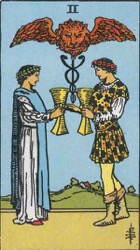 |
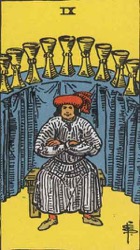 |
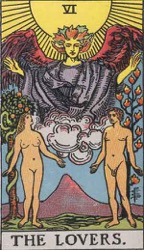 |
 |
 |
© Phuture Me Ltd 2018. All rights reserved.
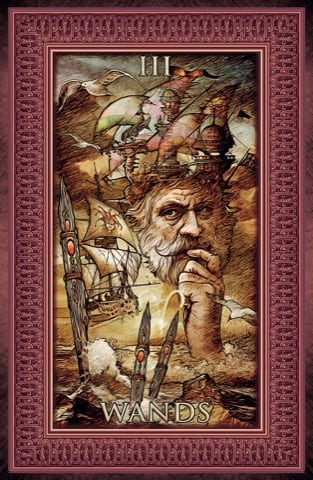
The 3 of Wands is the organiser who relies on their connections, and the ability to communicate with others, to get things done. For example, a night out with friends, or a party, needs someone to take the initiative, gather consensus on time, date and venue and then make sure that everyone is informed and all the necessary bookings are made. As the Suit of Wands, and the element of Fire, deals with energy, passion, home, community and work that example must be taken into context. In the work place the 3 of Wands could be referring to the marketing of products or the logistics of shipping to retailers or customers. Project management requires excellent communication skills, diplomacy and the ability to motivate and inspire others to come together in harmony and get things done.
In numerology the number 3 is the expressive communicator which is highly creative, as seen in the 3 Of Pentacles. The number 3 also represents the feminine virtue of nurturing as seen in the The Empress and social gatherings as seen in the 3 Of Cups. The negative attributes of the number 3 are childish irresponsibility, lack of discipline, being directionless, scattering energy, having no focus and attention seeking. The 3 of Wands is a good card but it should also be taken as a warning, with the 3 Of Swords kept in mind, that success and happiness are not guaranteed. This card indicates that work needs doing and there maybe consequences if the 3 is allowed to express it's negative side.
Pamela C. Smith's 3 of Wands in the Rider Waite Smith (RWS) deck depicts a man standing on a hill over looking a sea with 3 ships passing by. This, according to her co-author Arthur E. Waite, is a merchant who has sent his products off to be sold and is now waiting for his ships to return. Tarot comes from a time before telegraph wires, even the RWS deck was created when long distance communication was mainly by ship. The 3 ships may well be heading for 3 or more different ports. There's a lot of communication in this symbolism which would be the equivalent today of writing one or more emails and sending them to not just one person but groups of people. There's a need to express plans, ideas and creative thoughts and see what comes back. If all the work and preparations have been done well enough, and luck is on the merchant's side, then success is assured. The artist placed 2 wands on the right, in the future, of the merchant and 1 wand on the left in the past. This was probably to remind us, through numerology, of the need for someone to take the initiative to get this project going by the single wand in the past position, which references the Ace of Wands. The 2 wands in the future position represents the diplomacy required once those ships reach their destinations in making fair trade and strengthening distant bonds.
The 3 of Wands, 3 of Rods or 3 of Batons is a card of creativity in the home or work place through social engagement. The element here is Fire which relates to home, community, work, energy, passion and drive. The aspects of the number 3 in numerology are the joy, expressiveness, communication, social gatherings and creativity. This card can point to working with others being creative in the home or work place which should be a successful and happy venture.
© Phuture Me Ltd 2010-2018. All rights reserved.
THE PICTORIAL KEY TO THE TAROT
By Arthur Edward Waite (1911)
A calm, stately personage, with his back turned, looking from a cliff's edge at ships passing over the sea. Three staves are planted in the ground, and he leans slightly on one of them. Divinatory Meanings: He symbolizes established strength, enterprise, effort, trade, commerce, discovery; those are his ships, bearing his merchandise, which are sailing over the sea. The card also signifies able co-operation in business, as if the successful merchant prince were looking from his side towards yours with a view to help you. Reversed: The end of troubles, suspension or cessation of adversity, toil and disappointment.
Related Tarot Cards
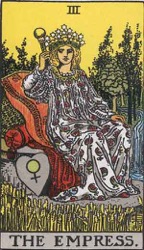 |
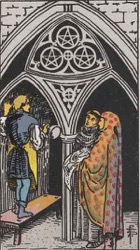 |
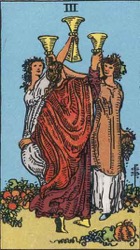 |
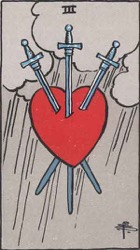 |
© Phuture Me Ltd 2018. All rights reserved.
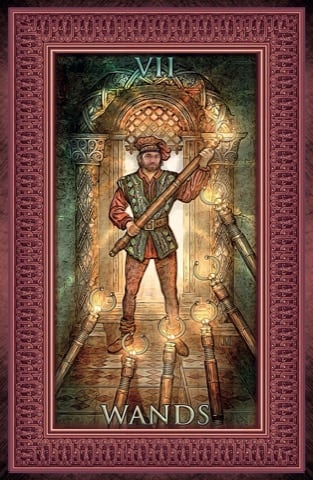
Defensiveness is the obvious main theme in the Seven of Wands but we must remember that there are other defensive cards in the Tarot deck. To help better understand the deeper meaning of the Seven of Wands it's worth reviewing and comparing all these defensive cards.
The Knight of Cups and the Knight Of Pentacles are defenders of the heart and wealth respectively. Both hold forward the emblem of their element as a possible peace offering. The Chariot's defensiveness is more subtle but this card is also a 7 and represents an unchallengeable defensive position due to high ranking status. To get to him you need to defeat his army of the four elements first. Finally we get to the Knight of Wands who is fighting to control his steed's eagerness to charge. It makes no sense to have two cards for defence in the same suit. The Wand's Knight therefore focuses on defending against bad decisions, reckless energy and forces that could result in heading in a wrong direction. The element of Fire is about passion, energy and drive which, if uncontrolled, can be damaging and dangerous.
The Seven of Wands is depicted in the Rider Waite Smith deck as a plainly dressed man holding a wand as if he were using it as a quarterstaff (a traditional European pole weapon). It's worth noting that for a defensive character he wears no armour but he is positioned on the high ground from which it is easier to defend from. The six remaining wands are upright in front of him. The artist, Pamela Coleman Smith, has illustrated this card in a way that leaves the role of these six wands ambiguous. Are they held by attackers, who are below the picture frame and out of site, trying to knock this man down? Or are they a defensive barrier which he has made in front of him as a make shift fortification?
The direction our character faces is an important point to note as the artist could have made him face right or east, symbolising the future, in preparedness for oncoming assaults. Instead she has him facing us which puts the card's time focus in the present moment. This detail may suggest an alternative scenario for the six wands being held by attackers. They may be passing by our character heading from the right (future) to the left (past). Look at the preceding card in this suit, the 6 Of Wands, and imagine this group marching by led by the man on the horse. The message from the Seven of Wands could be to hold one's ground and allow the threat to pass by. You have the high ground and no action is needed on your part if you stand firm.
The Page Of Swords has many visual similarities in the Rider Waite Smith deck. Both stand on raised ground brandishing a weapon, but wearing no armour, dressed in plain, simple tunics. The obvious differences are their weapons, which symbolise their elemental domains, and a lack of any visible threat to the Page of Swords. The more subtle difference is the direction in which they each face. The Page's body is pointing right towards the future but his head is turned looking back, at the past, over his right shoulder. This difference should emphasise that the Seven of Wands deals with immediate and real challenges, threats or attacks. The Page of Swords deals with imaginary future threats due to past experiences which may, or may not, repeat in the future.
The 7 of Wands, Rods or Batons can represent standing firm and unmovable in the face of an immediate challenge or threat. The element here is Fire which relates to home, community, work and creativity. The aspects of the number 7 in numerology are contemplation, reflection, thought before action, rest, withdrawal, introspection and research. As with all 7's the 7 of Wands advises planning and preparation before any action.
© Phuture Me Ltd 2010-2018. All rights reserved.
THE PICTORIAL KEY TO THE TAROT
By Arthur Edward Waite (1911)
A young man on a craggy eminence brandishing a staff; six other staves are raised towards him from below. Divinatory Meanings: It is a card of valour, for, on the surface, six are attacking one, who has, however, the vantage position. On the intellectual plane, it signifies discussion, wordy strife; in business--negotiations, war of trade, barter, competition. It is further a card of success, for the combatant is on the top and his enemies may be unable to reach him. Reversed: Perplexity, embarrassments, anxiety. It is also a caution against indecision.
Related Tarot Cards
 |
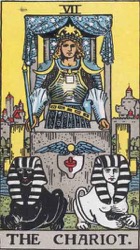 |
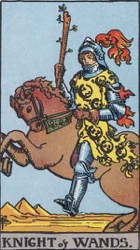 |
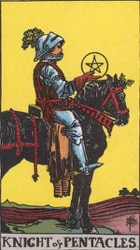 |
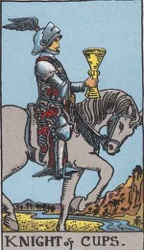 |
© Phuture Me Ltd 2018. All rights reserved.
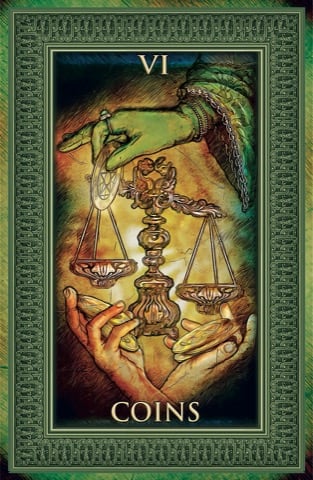
There is a reverence towards some numbers due to their reputed ability to attribute power, success or wealth such as the numbers 1, 3 or 8. They may have a focus on those pursuits but they also come with a balanced amount of challenges too. Take a look at the number 8's in Tarot's minor arcana for examples of why the 8 won't always be a road to riches and success. The number 3 is connected with joy, happiness and expressing it in celebration but it also suffers from being a bit careless and childish. It needs adult supervision.
The number 6 tends to be overlooked but it can be the most harmonious number of all 9. Its central theme is one of responsibility and service to others which is perhaps why it tends to be ignored. However what Tarot's imagery does very well is to point out that to be able to be of service to others, and giving of oneself, you need to be in a good place to do so. This is emphasised by the depiction of the Garden of Eden in card number 6 of Tarot's Major Arcana, The Lovers, in the Rider Waite Smith (RWS) deck. Rather than striving to be successful and having it all, as those who pursue the 1's and 8's do, the 6 is symbolic of having already achieved that status. To be the Philanthropist, depicted in the RWS Six of Pentacles card, you need to have it to be able to give it away. If you are looking for an auspicious number consider the number that symbolises having arrived at success rather than the numbers that promises a possible road to success.
The 6 of Pentacles, or The 6 of Coins, is a card of philanthropy, benevolence, generosity, material justice and financial commitment to family, friends or community. The element here is Earth which relates to wealth and material possessions. The aspects of the number 6 in numerology are home, responsibility, domesticity, burden bearing, service to others and family. As much as this is a card of spending, or giving, for those who are in need it is also an auspicious card for being in a financial, or material, position to be able give.
© Phuture Me Ltd 2010-2018. All rights reserved.
THE PICTORIAL KEY TO THE TAROT
By Arthur Edward Waite (1911)
A person in the guise of a merchant weighs money in a pair of scales and distributes it to the needy and distressed. It is a testimony to his own success in life, as well as to his goodness of heart. Divinatory Meanings: Presents, gifts, gratification another account says attention, vigilance now is the accepted time, present prosperity, etc. Reversed: Desire, cupidity, envy, jealousy, illusion.
Related Tarot Cards
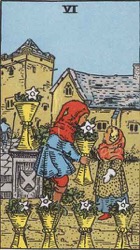 |
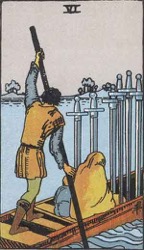 |
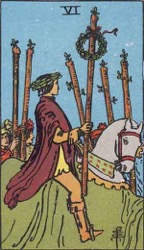 |
 |
© Phuture Me Ltd 2018. All rights reserved.
Free AI Tarot Reading. Sample the Future!
Artificial Intelligence reads Tarot Cards so well you have to see it to believe it!
We'd love for you to try it for FREE and see for yourself why this excites us.
